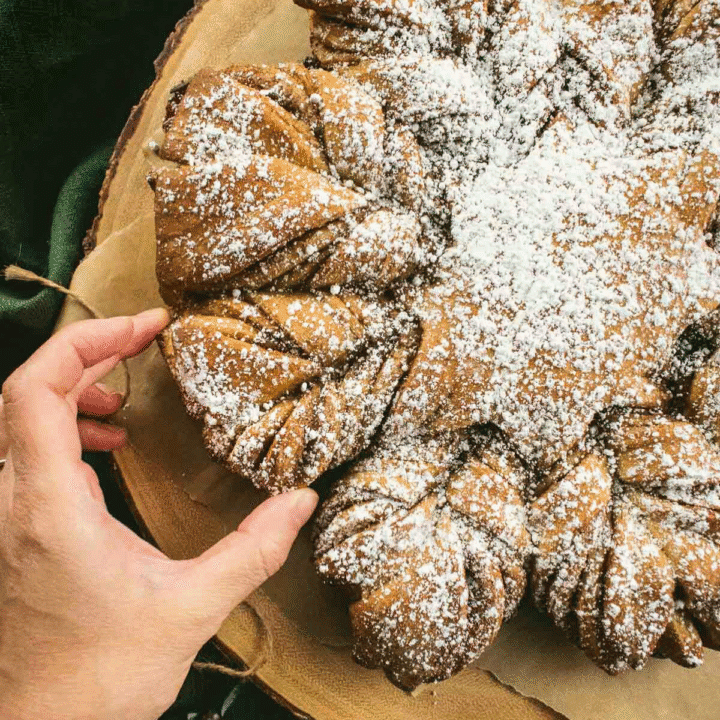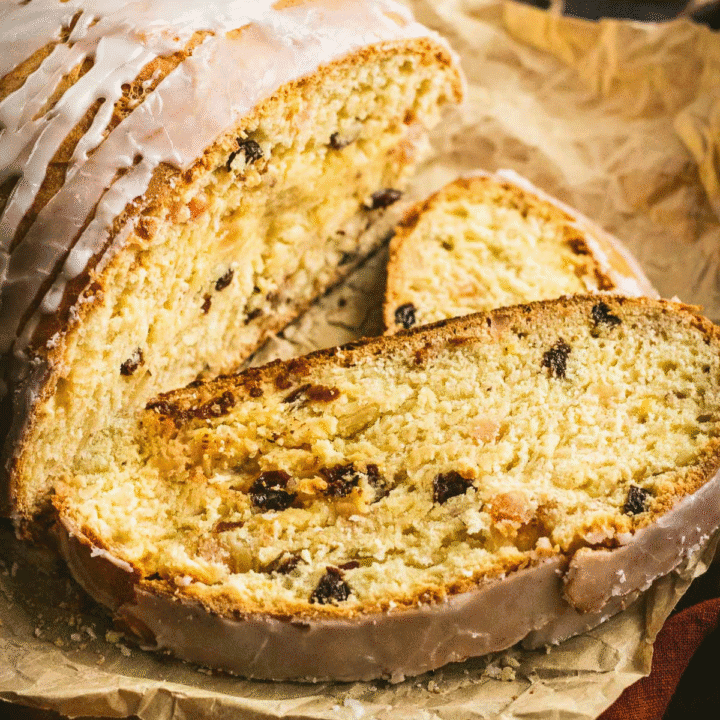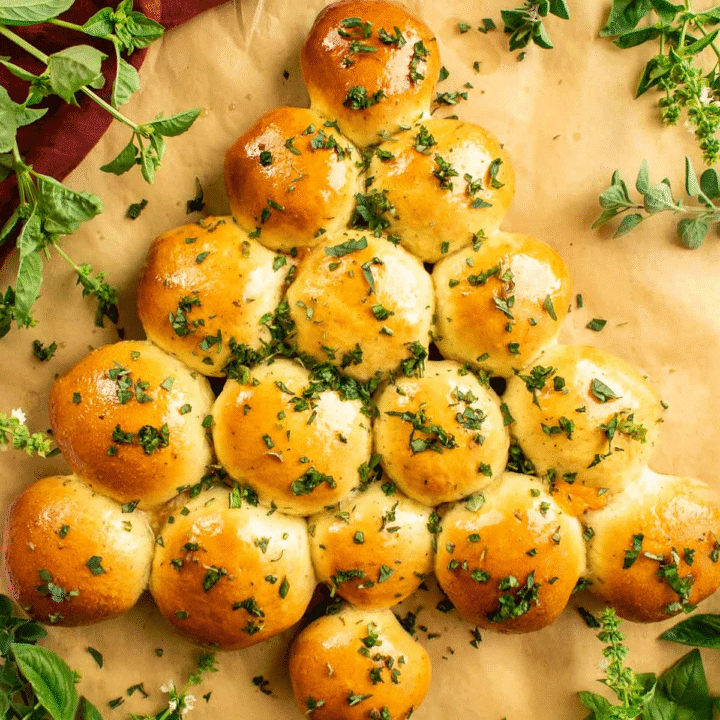I love a good hearty loaf, and one of my favorites for sandwiches and toast is this authentic German spelt bread called Dinkelbrot. It's made with sourdough, whole grain spelt flour, and just a little whole wheat flour to improve its chewy texture.

This website uses affiliate links which may earn commission for purchases made at no additional cost to you.
Authentic German spelt bread is a classic hearty bread that's filling and flavorful. But it's lighter than Schwarzbrot or Volkornbrot which are made with rye flour. Spelt has a lighter, nutty flavor that's still way more delicious than boring white balloon bread.
Dinkelbrot in German translates to "spelt bread". This delicious rustic bread is made mostly with spelt flour, which is considered an ancient grain. I also like to add just a little whole wheat flour, to add more gluten to the dough and help its structure.
This Dinkelbrot recipe was inspired by my other easy German bread recipes, and tastes great with a generous smear of homemade vegan butter, jam, or chocolate almond butter. Or spread 5 minute parsley pesto on a couple slices with cheese, veggies, and meat for a delicious sandwich!

Types of Spelt Bread
Depending on the recipe you follow, or the German bakery (Bäckerei) you get your Dinkelbrot from, it can vary in size and shape.
Sometimes spelt bread loaves are baked in a loaf pan as sandwich loaves, so they're ideal for slicing thinly.
Other times they're baked free-form in a round (boule) shape, which is great for thicker slices to dunk into cozy soups.
And the flavor may differ as well, since it can be made with or without a sourdough starter.
Growing up in Germany, we often enjoyed German loaves made with sourdough, which greatly enhances the bread's delicious flavor.

The sourdough adds a depth of flavor, and makes loaves taste more authentically German.
But everyone's sourdough starter is so different, based on a wide array of factors including what type of flour you feed it, when and how often you feed it, the moisture and temperature of the air, your water quality, and so much more.
Sourdough Versus Instant Yeast
I say, why not both? I personally like using just sourdough, but if you're worried about your bread rising, add ½ teaspoon of instant yeast when you mix your dough.
Trust me, I know that one of the worst feelings is to spend two days baking bread just to have it fall flat,. And if I can help my fellow bakers avoid that defeat, then that's a win in my book! 🙂
How to Make this Recipe
Below is the process to make this recipe. For the full step-by-step directions and ingredient quantities, scroll down to the recipe card at the bottom of this post.

1. In a large mixing bowl, dissolve the sourdough starter in warm water.

2. Add the spelt flour and whole wheat flour. Mix with a large spoon.

3. Cover the bowl with a towel and rest at room temperature for 3 to 4 hours, until it doubles in size.

5. Add the spelt flour, whole wheat flour, and salt. Mix to combine everything.

7. Return the dough to the mixing bowl. Let it rest overnight, until it doubles in size.

9. Cover the dough with a clean kitchen towel and let it proof for about 3 hours at room temperature, until it puffs up.

4. In a large mixing bowl add 200 grams of the levain with the water. Whisk it to dissolve the levain.

6. Knead the dough by hand for five minutes, until it's elastic but still feels a little wet.

8. Shape the dough into a log and place it in a greased loaf pan with the same facing down.

10. Bake the bread at 425°F for 35 to 40 minutes, until the loaf is golden brown & has an internal temp of 200°F to 210°F.

Carissa's Kitchen Tip
Make sure your sourdough is active! Otherwise your German spelt bread won't rise properly.
Your sourdough starter should be light, airy, and bubbly. And it should have been fed recently. 🙂

Tips for Baking with Spelt Flour
- Similar to many rye bread recipes with sourdough, we want to make a levain. This simple step of mixing a little sourdough, flour, and water together & leaving it to rest for a bit makes a world of difference.
It hydrates the dough so it's easier to work with, since spelt flour doesn't absorb water as readily as regular wheat flour.
- Be careful not to over-mix the dough. Spelt dough is more fragile than whole wheat or white bread dough, since its gluten structure isn't quite as strong. Knead it gently to prevent it from becoming tough and dense.
- If you can't find spelt flour, you can substitute whole wheat flour. But note that your bread will be more dense and hearty, and it won't have that subtly sweet and nutty flavor that's unique to spelt.
- Use an kitchen thermometer to test when your bread is done baking. I recently started doing this, and it is especially helpful for loaves baked in pans like this Dinkelbrot. Place your thermometer into an outer edge of the loaf pointing towards the center to get an internal temperature reading.

Variations
- Toppings: You can leave your Dinkelbrot loaf plain, or brush it with olive oil and sprinkle hulled sunflower seeds or sesame seeds on top before baking it.
- Soaker: Sometimes a "soaker" is added to the dough, which is made of a grain like steel cut oats soaked in water. This adds a hearty texture, flavor, and nutrition to the loaf, but I think it makes Dinkelbrot a little too heavy for my preference.
- Types of Spelt Flour: I recommend using whole spelt flour for its richer flavor and darker color which make this loaf more authentically German. But you could substitute white spelt flour for softer, lighter bread.
Storage
- Room Temperature: Allow the loaf to cool completely, then store it in a paper bag, kitchen towel, or ventilated bread box at room temperature for up to 4 days.
- Fridge: If you live in a really hot, humid area, you'll want to store your bread in the fridge rather than at room temperature so it doesn't get moldy as quickly. Wrap it in plastic wrap or a plastic bag and store it in the fridge for up to 4 days.
- Freezer: You can also freeze the bread for up to 3 months, wrapped tightly in plastic cling wrap then in aluminum foil.

Related Recipes
Looking for more sourdough and yeast bread recipes like this whole spelt sourdough bread? Try these:

German Spelt Bread with Sourdough (Dinkelbrot)
Ingredients
Levain
- 50 grams active, bubbly sourdough starter
- 80 grams warm water (between 80°F and 90°F)
- 50 grams spelt flour
- 50 grams whole wheat flour
Dough
- 200 grams levain
- 350 grams warm water (between 80°F and 90°F)
- 400 grams spelt flour
- 100 grams whole wheat flour
- 10 grams salt (use non-iodized table salt or fine sea salt)
Instructions
Prepare the Levain
- In a large mixing bowl, whisk the sourdough starter and warm water until the sourdough is dissolved.
- Add the spelt flour and whole wheat flour and mix with a large spoon.
- Cover the bowl with a clean kitchen towel and allow it to rest at room temperature for 3 to 4 hours, until it doubles in size.
Prepare the Dough
- In a large mixing bowl add 200 grams of the levain (which isn't all of it!) with the water. Whisk it to dissolve the levain.
- Add the spelt flour, whole wheat flour, and salt. Mix it in the bowl with a large spoon to combine everything.
- On a clean work surface, knead the dough by hand for five minutes, until it's elastic. This dough will be more wet than other bread doughs, because spelt flour needs more hydration. The dough is done being kneaded once it's relatively elastic and smooth, but it will still feel a little wet and slightly sticky.
- Return the dough to the mixing bowl. Cover it with a clean kitchen towel and let it rest overnight, for about 8 hours, until it doubles in size. Continue on to the next step right away, or refrigerate the dough for up to 12 hours.
- Grease a loaf pan with a little olive oil or butter.
- Shape the dough on a clean work surface into a log. Gently push the sides of the dough down and underneath it to create tension on top. Place the shaped dough into the prepared loaf pan with the seam facing down.
- Cover the dough with a kitchen towel and let it proof for about 3 hours at room temperature, until it puffs up. When you gently press into the top with your finger, the indentation should slowly spring back to its original shape after a few seconds.
Bake the Bread
- Preheat the oven to 425°F.
- Bake the bread for 35 to 40 minutes, until the loaf is golden brown and has an internal temperature of around 200°F to 210°F.
- Remove the loaf from the loaf pan and let it cool completely to room temperature on a cooling rack for at least a couple hours. Then slice and enjoy!!
Notes
- Levain: The levain hydrates the dough so it's easier to work with, since spelt flour doesn't absorb water as readily as regular wheat flour. And it ensures your sourdough is active and ready to rock & roll!
- Don't Overmix: Be careful not to over-mix the dough. Spelt dough is more fragile than whole wheat or white bread dough, since its gluten structure isn't quite as strong. Knead it gently to prevent it from becoming tough and dense.
- Test for Doneness: Use an kitchen thermometer to test when your bread is done baking. Place your thermometer into an outer edge of the loaf pointing towards the center to get an internal temperature reading.
- Types of Spelt Flour: I recommend using whole grain spelt flour for its richer flavor and darker color which make this loaf more authentically German. But you could substitute white spelt flour for softer, lighter bread.
- Storing: Store your cooled loaf at room temperature for up to 4 days or in the freezer for up to 3 months.










shkalen
Takes me back
Rolf
My dad said he used to have this a lot when growing up in Germany